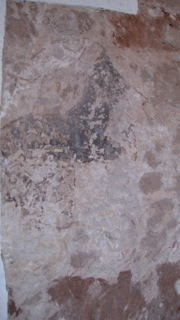Karen Overbey, Tufts University
Friday, February 2, 2011
7:30pm
CUNY Graduate Center • 365 Fifth Avenue
English Department Lounge • Room 4409
Wine and cheese reception following the talk
The visual culture of St Kenelm, however, is much less familiar -- and in fact, very little remains. The only known narrative representations are fourteenth-century wall paintings at a small chapel in Worcestershire, which were destroyed in the nineteenth century, and survive only in partial drawings and a few textual descriptions.
It is impossible to reconstruct the entire painting cycle, but the traces suggest that the cult in Worcestershire -- where there were neither relics nor shrine, and no record of healing miracles -- was grounded in the local landscape, in holy wells and sacred trees and pastures; although Winchcombe held the saint’s relics, the chapel stood on the site of his martyrdom. The relationship between the “lost” wall paintings and the textual hagiography of Kenelm is not straightforwardly iconographic, and understanding the function of the pictures requires us to consider not only what we see, but also what we don’t see.
*********
Please join us--we hope to see you there!


No comments:
Post a Comment